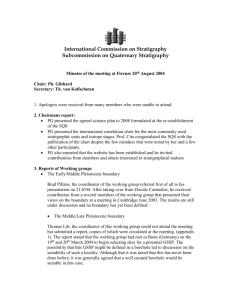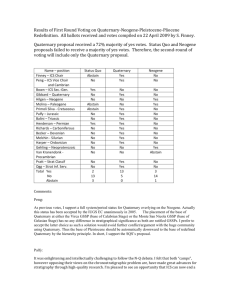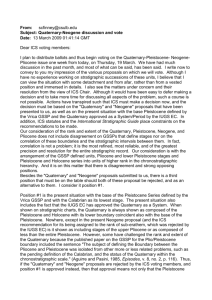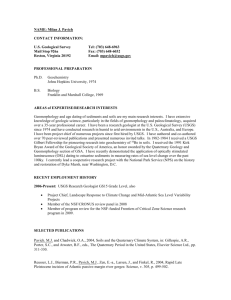Results of the ICS - Subcommission on Quaternary Stratigraphy
advertisement
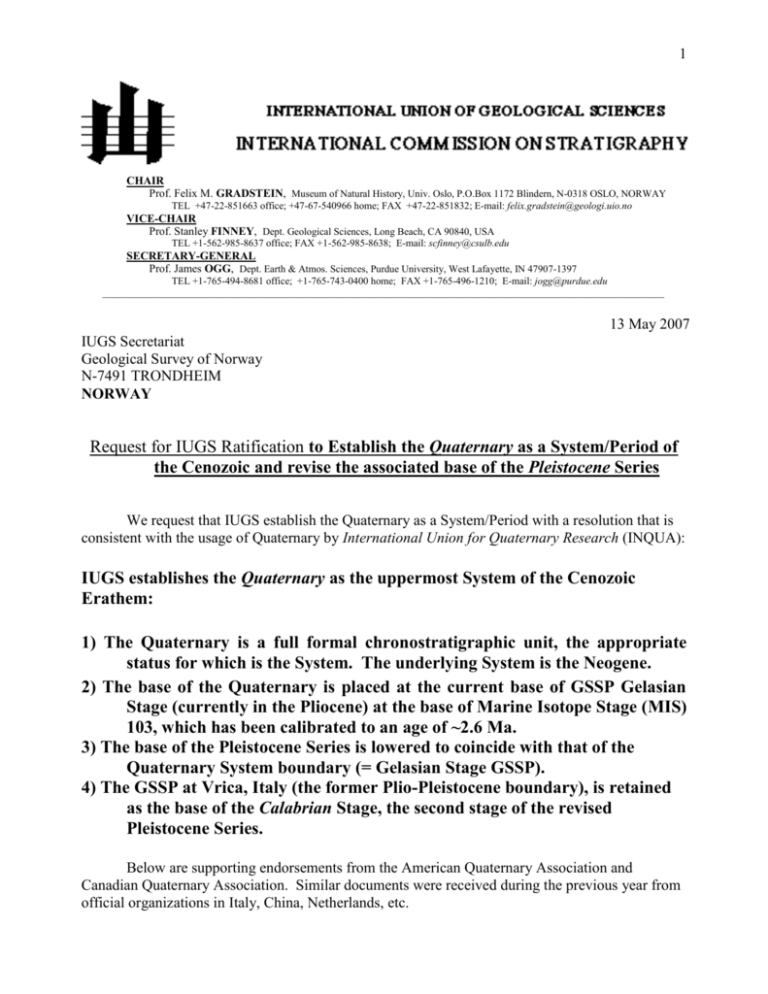
1 CHAIR Prof. Felix M. GRADSTEIN, Museum of Natural History, Univ. Oslo, P.O.Box 1172 Blindern, N-0318 OSLO, NORWAY TEL +47-22-851663 office; +47-67-540966 home; FAX +47-22-851832; E-mail: felix.gradstein@geologi.uio.no VICE-CHAIR Prof. Stanley FINNEY, Dept. Geological Sciences, Long Beach, CA 90840, USA TEL +1-562-985-8637 office; FAX +1-562-985-8638; E-mail: scfinney@csulb.edu SECRETARY-GENERAL Prof. James OGG, Dept. Earth & Atmos. Sciences, Purdue University, West Lafayette, IN 47907-1397 TEL +1-765-494-8681 office; +1-765-743-0400 home; FAX +1-765-496-1210; E-mail: jogg@purdue.edu ________________________________________________________________________________________________________________ 13 May 2007 IUGS Secretariat Geological Survey of Norway N-7491 TRONDHEIM NORWAY Request for IUGS Ratification to Establish the Quaternary as a System/Period of the Cenozoic and revise the associated base of the Pleistocene Series We request that IUGS establish the Quaternary as a System/Period with a resolution that is consistent with the usage of Quaternary by International Union for Quaternary Research (INQUA): IUGS establishes the Quaternary as the uppermost System of the Cenozoic Erathem: 1) The Quaternary is a full formal chronostratigraphic unit, the appropriate status for which is the System. The underlying System is the Neogene. 2) The base of the Quaternary is placed at the current base of GSSP Gelasian Stage (currently in the Pliocene) at the base of Marine Isotope Stage (MIS) 103, which has been calibrated to an age of ~2.6 Ma. 3) The base of the Pleistocene Series is lowered to coincide with that of the Quaternary System boundary (= Gelasian Stage GSSP). 4) The GSSP at Vrica, Italy (the former Plio-Pleistocene boundary), is retained as the base of the Calabrian Stage, the second stage of the revised Pleistocene Series. Below are supporting endorsements from the American Quaternary Association and Canadian Quaternary Association. Similar documents were received during the previous year from official organizations in Italy, China, Netherlands, etc. 2 INQUA will directly send IUGS an official statement from its executive board to endorse this important recommendation. Ideally, the Quaternary will be formally established as a global chronostratigraphic system with the associated revision of Pleistocene by the IUGS prior to the INQUA Congress (Cairns, Australia, early August, 2007). The ICS desires to send one or two of its officers to that INQUA Congress to officially present the decision and its background. Brief background: As part of the ratification of the Pleistocene GSSP in 1985, the status of the Quaternary was left undecided by IUGS/ICS: “The subject of defining the boundary between the Pliocene and Pleistocene was isolated from other more or less related problems, such as the pending definition of the Calabrian, and the status of the Quaternary within the chronostratigraphic scale.” -- E. Aguirre and G. Pasini (1985, The Pliocene-Pleistocene Boundary. Episodes 8: 116-120. = official publication of the base-Pleistocene GSSP decision by the special joint INQUA-ICS working group). Even though various publications, including a joint IUGS/ICS/UNESCO publication in 2000, have displayed a Quaternary with varying status and span, neither the ICS nor IUGS has formally voted to define the Quaternary or assign it an official rank. In particular, the definition of Quaternary promoted by INQUA is not consistent with some other versions (e.g., the IUGS chart of 2000). The vast majority of active “Quaternary” researchers and associations regard the Quaternary as beginning at the base of the Gelasian Stage (ca. 2.6 Ma) of the current upper Pliocene. The onset of this Quaternary is a major climatic, oceanographic and evolutionary shift in the global Earth system and its continental ecosystems. However, this episode is nearly 800,000 years prior to the traditional base-Pleistocene (ca. 1.8 Ma) at the level when certain cooler-water marine fauna enter the Mediterranean. In 2005, both the joint INQUA-ICS Task Group and the full ICS unanimously agreed with this definition for the base of the Quaternary (ca. 2.6 Ma), and that the Quaternary should be given a formal chronostratigraphic rank. Two options for rank of Quaternary had been submitted by the joint Task Group with equal preference – sub-era (hence allowing a preceding “Tertiary” sub-era) or system/period (inserted above the current Neogene system). The majority (70%) of ICS preferred the option of “sub-era”, and this was submitted to IUGS in late 2005, but was rejected by IUGS in early 2006 because it violated aspects of chronostratigraphic hierarchy and introduced a new class of chronostratigraphic unit. The second option of “system/period” would require a revision of the assignment of chronostratigraphic stages between the Pleistocene and Pliocene series. After extensive discussions, including dialogs with INQUA and regional stratigraphic commissions, International Commission of Stratigraphy has approved the following major package on the system-series-stage hierarchy for the late Cenozoic. Part of that compromise package is that the Gelasian Stage be shifted from the Pliocene Series to the Pleistocene Series in order to maintain a hierarchy in the chronostratigraphic scale. 3 This proposal had been revised following an initial month-long ICS discussion phase (March-April), after which an appropriate ballot was transmitted to ICS for final voting during April-May 2007. At that time, the position of the Neogene Subcommission was also circulated (attached after Vote Summary below.). The appendices to this letter include selected items that were part of the discussion phases by the ICS. Please notify the ICS secretary if any additional documentation is desired. The votes received from the Full Commission to submit this Quaternary resolution were 14 “Yes”(82%), 2 “No” (12%) and 1 “Abstain” (details, and summary of remarks are on the next pages). One member did not vote. If ratified, then a modified form of this important resolution to revise the upper Cenozoic chronostratigraphy will be published in Episodes. The ICS will immediately indicate the proposed establishment of this Quaternary system and associated revision of the Pleistocene series on its official website, graphics and visualization software. Sincerely, Jim Ogg James G. Ogg (Secretary-General of the ICS) 4 Proposed Upper Cenozoic chronostratigraphy, showing current status of ratified GSSPs for Stages [“Ionian” is a potential name for the third stage of the Pleistocene, but the formal name will be established when the GSSP is ratified during the coming year.] 5 6 7 VOTE SUMMARY To request IUGS to establish the Quaternary as a System, including shifting the Gelasian Stage to the Pleistocene Series TOTALS 14 Yes (82%), 2 No (12%), 1 Abstain (6%); with several remarks 1 vote was not received Office Name Vote Comments Chair Gradstein YES [Favors retention of “Tertiary” as an informal sub-era] Vice-Chair Secretary Finney Ogg YES YES Quaternary Gibbard YES Neogene Hilgen NO Paleogene Cretaceous Jurassic Triassic Permian Molina Premoli Silva Morton Orchard Henderson YES YES YES [see comments on next page] [none received] YES “This seems like a good solution to me, which Carboniferous Heckel YES Devonian Silurian Ordovician Becker Rong Jiayu Chen Xu YES YES YES . “A sub-era status for Quaternary would have been preferable, rather than truncating the classical Neogene system, but it is necessary to make compromises. A slightly lower base at MIS 106, the first major glacial episode at ca. 2.7 Ma, should be considered in the future.” “This is an historical decision and one that I support wholeheartedly!” [see comments of Neogene Subcommission on next page] should please more people than our last proposal – but still not all!.” “After discussing this issue with my colleagues who work on the Quaternary, I believe that this is the best way to resolve this longstanding problem.” “Yes!” 8 Cambrian Ediacaran Peng Shanchi Gehling YES NO Precambrian Classification Bleeker Cita ABSTAIN YES “The “Quaternary” and “Tertiary” are remnants of the Neptunist concept of stratigraphy, and should go the way of the “Primary” Transitional” and “Secondary” divisions of geological time. The only reason for retaining the Quaternary as a Period/System is that its use is so widespread. I do support parts 3) and 4) of the voting package, only.!” [see comments on next page] “We are submitting a manuscript to Episodes on “The Quaternary Calabrian Stage: An Update” to help substantiate the decision. It consists of a historical background and of a presentation of observational data novel or derived from the recent literature in an integrated stratigraphy scenario, with a multidisciplinary approach. The proposed ICS sponsored Symposium on “Pliocene/Pleistocene Correlations and Climate Change” with M.B. Cita and B. Pillans as conveners has been approved by the Oslo 2008 IGC Organizing Committee. The INQUA sponsorship is requested.” ******************************************* Comments by Nicol Morton, chair of Jurassic Subcommission; 30 April 2007 The letter from IUGS Executive instructed ICS to enter into renewed dialogue with INQUA. The proposed response goes beyond this and revises definitions in line with INQUA preferences, though it must be corrected to specify definition of the base of the Quaternary at a GSSP rather than at a numerical value of age. The ICS meeting in Leuwen approved, unanimously or nearly so as far as I can recall, recognition of the Quaternary as a formal chronostratigraphic unit, with the definition of the base of the Quaternary at the GSSP for the base of the Gelasian. The problem lies with the "majority" vote to have parallel scales and infringe the rules which ICS had established of hierarchy of chronostratigraphic units. I voted very reluctantly for this "compromise", though I indicated at the time, and later, problems with it. It was not a surprise to me that it was not accepted elsewhere. Personally, I have never understood the Neogene to extend to the Present; it was always, for me and for almost everyone I know, succeeded by a Quaternary of equal status. There is little to be gained now from going over previous decisions, some correct at the time, others apparently misguided. To avoid a long further discussion on this topic, I vote for the recognition of the Quaternary as the final Period/System of the Cenozoic, with subdivisions Holocene and Pleistocene and the Gelasian Stage transferred from Pliocene to Pleistocene in order to maintain the principle of hierarchy. This also maintain the principle that only the bases of chronostratigraphic units are defined, the top being established by the definition of the base of the overlying unit. Comments by Wouter Bleeker, chair of Precambrian Subcommission; 12 May 2007 Although this proposal represents progress, as indeed the Quaternary should have formal status in the ICS time scale, it does not resolve the conflicting views which resulted, finally, and after much consultation, 9 in the “Leuven compromise” [which was that the Quaternary should be a sub-era]. This compromise, in my view, was reasonable and had the added advantage of also allowing re-instatement of the Tertiary at a similar rank. Although the proposal satisfies INQUA, it is clearly unacceptable to the Neogene stratigraphic community, as summarized by the Neogene Subcommission Chair in a recent communication. Indeed this subcommission can lay some claim to this part of the time scale. The whole process thus seems a departure from established ICS procedures, with a subcommission being overruled by a position imposed from the outside. I vote "Abstain" because at some point it may be more productive to move on. … Yet, I still think the Leuven compromise has a certain beauty. It simply should have gone one step further by also lowering the boundary of the Pleistocene as in the present proposal. Something tells me that this debate won’t go away 10 Letter to ICS from Frits Hilgen, chair of Neogene Subcommission; 12 April 2007 NOTE – This Neogene Subcommission position was circulated to all ICS members at the end of the discussion phase, prior to voting on the ballot. Therefore, the ICS voting had taken this position into consideration during the decision process. Dear Jim, ICS bureau and sub-commission chairs, Hereby the formal reaction of SNS, after consulting its members, on the concept of the proposal from ICS to send the INQUA proposal about the definition of the Quaternary and N/Q boundary directly to IUGS for approval. The reaction is based on the response received thus far. It is clear that the majority of SNS members find the proposal totally unacceptable, but this may not come as a surprise following the outcome of the SNS questionnaire in preparation of the Leuven workshop in 2005. Summarizing, it is not understood by SNS members: - why we should give in to pressure from IUGS and INQUA and abandon our own principles and rules; - why the compromise solution (i.e., in the Aubry et al., 2005, Episodes paper) that came out of the Leuven meeting is not acceptable for IUGS (is it only because it does not follow the “preferred” strict hierarchy of the chronostratigraphic scale?), and; - why ICS did not push harder to get that solution accepted. Based on the responses, four options favoured by SNS members emerged: 1) keep the present formal status with the Pliocene/Pleistocene and base Quaternary defined at Vrica at 1.81 Ma (9 in favour); 2) let INQUA have its own Quaternary climatostratigraphic time scale chart (10 in favour); 3) follow the INQUA option (3 in favour), and; 4) lower the Pliocene/Pleistocene boundary to 2.6 Ma equivalent with the (lowered) base of the Quaternary, but with the Quaternary as an Epoch and the Neogene extending to the Present (5 in favour). The first solution is conservative and may at the end be the one favoured by IUGS if no other solution is reached. The idea is not to change the current definition as long as the outcome of the ongoing debate (if that will ever end) is unclear. The second option is also easy to grasp and partly comes from the fact that INQUA decided to go its own way and separated from IUGS to become a full member of the ICSU (International Council for Science) implying that INQUA and IUGS are now independent unions (of equal status) under the ICSU. In fact, this would imply that the position of INQUA is no longer a major concern to us. In addition, having INQUA let its own scale would give justice to the two main marine and continental 11 based traditions in the chronostratigraphic subdivision of the youngest part of the stratigraphic record. Moreover, it is not that far off from the compromise solution that came out of the Leuven meeting. It also has the additional advantage to get rid of the “superstages” preferred by INQUA; they can be included in their own scale, and we only have to make sure that our normal marine stages of the Pleistocene agree with their “superstages”. The third option is the INQUA option. The fourth option looks a bit like a variant of the compromise solution advocated in the Aubry et al. (2005) paper, but with important differences namely the Quaternary as an Epoch (instead of Subera) and the Pliocene/Pleistocene boundary lowered from 1.8 to 2.6 Ma. We can then add a fifth solution to this list which is the compromise solution already reached during the ICS workshop held in Leuven two years ago itself. Clearly there is lack of understanding within the Neogene community why this solution was not taken more serious by INQUA and IUGS (and ICS). SNS therefore asks ICS to abandon the proposed procedure for ICS voting on the Quaternary issue because the majority of SNS members does not agree with the INQUA solution advocated in the proposal and it is Neogene that is (also) at stake here. In addition SNS finds the procedure itself incorrect and therefore unacceptable. This may not come as a surprise considering the fact that the Neogene community risks the danger of being passed over (this is the “not all people will be happy”, and of course this is not possible if we follow our own - normal - rules and procedures) and that ICS seems to be willing to give up its own procedures and principles to please IUGS and INQUA. If the ICS bureau nevertheless decides to continue with the procedure, we ask the voting members not to accept the proposal. It would be insupportable if the ballot would result in an outcome that is totally opposite from the outcome of the formal ballot two years ago in Leuven. SNS is still willing to look for an acceptable compromise that does justice to both practices in subdividing the youngest part of the time scale. It thereby still considers the solution that we accepted in Leuven as the best solution. If INQUA is not willing to accept such a compromise, then the best solution might well be to let them have their own Quaternary scale. With best regards, Frits Hilgen Utrecht, April 12, 2007 12 Poll of Neogene Subcommission on the appropriate Quaternary definition/rank [March-April, 2007] Below is a summary of different opinions expressed by voting members of the Neogene Subcommission on the appropriate status/rank for the Quaternary, as interpreted and compiled by Frits Hilgen. Some members expressed more than one view. The comments are categorized according to positions elaborated by different members (see items 1 through 4 in main letter): “Vai option” = Retain current Pliocene/Pleistocene boundary at Vrica (1.81 Ma), which also sets base-Quaternary (chronostratigraphic rank yet to be decided) Couvering option = Quaternary is separate from official standard international scale of ICS. INQUA option = Quaternary established as a System, and Pleistocene base is shifted to 2.6 Ma. Kent option = Quaternary replaces Pleistocene as a Series/Epoch of Neogene, with base at 2.6 Ma. 13 APPENDIX 1 Ballot submitted to ICS [April, 2007]: VOTE BALLOT to request IUGS to establish the Quaternary as a System, including shifting the Gelasian Stage to the Pleistocene Series As part of the ratification of the Pleistocene GSSP in 1985, the status of the Quaternary was left undecided by IUGS/ICS. Even though various publications, including a joint IUGS/ICS/UNESCO publication in 2000, have displayed a Quaternary with varying status and span, neither the ICS nor IUGS has formally voted to define the Quaternary or assign it an official rank. This suspended status for the Quaternary has generated considerable anger among many geoscientists. IUGS has requested ICS to provide advice, based on a dialog with INQUA, on a mutually satisfactory resolution to the Quaternary issues prior to the 2008 International Geological Congress. A huge community considers that the beginning of the Quaternary is the base of the Gelasian Stage of the upper Pliocene. In 2005, both the joint INQUA-ICS Task Group and the full ICS unanimously agreed with this definition for the base of the Quaternary, and also that the Quaternary be given a formal chronostratigraphic rank. Given the strength of this preference, then ICS will vote on submitting to IUGS a unified package to establish the Quaternary as a System. Part of that package is that the Gelasian Stage be shifted from the Pliocene Series to the Pleistocene Series in order to maintain a hierarchy in the chronostratigraphic scale. ******************************************** We request that IUGS establish the Quaternary as a System/Period with a resolution that is consistent with the usage of Quaternary by International Union for Quaternary Research (INQUA): IUGS establishes the Quaternary as the uppermost System of the Cenozoic Erathem: 1) The Quaternary is a full formal chronostratigraphic unit, the appropriate status for which is the System. The underlying System is the Neogene. 2) The base of the Quaternary is placed at the current base of GSSP Gelasian Stage (currently in the Pliocene) at the base of Marine Isotope Stage (MIS) 103, which has been calibrated to an age of ~2.6 Ma. 3) The base of the Pleistocene Series is lowered to coincide with that of the Quaternary System boundary (= Gelasian Stage GSSP). 4) The GSSP at Vrica, Italy (the former Plio-Pleistocene boundary), is retained as the base of the Calabrian Stage, the second stage of the revised Pleistocene Series. 14 Herewith, I express the following vote to recommend this package to IUGS for their acceptance and ratification on the definition and rank of the Quaternary and on the associated shifting of the Gelasian Stage into the Pleistocene Series. O Yes O Abstention O No Name__________________________________________________________ ICS Subcommission/Office________________________________ COMMENTS: Date_________________ 15 APPENDIX 2 Recommendations [2005] by the Quaternary Task Group jointly of the International Commission on Stratigraphy (ICS, of the International Union of Geological Sciences, IUGS) and of the International Union for Quaternary Research (INQUA) Summary of recommendations The Quaternary Task Group recommends that the Quaternary be: (1) An officially ratified geochronologic/chronostratigraphic unit of the international geologic time scale, (2) Defined as the interval from the GSSP base of the Gelasian Stage (approximately 2.59 Ma) of the late Pliocene Epoch to the Present, and (3) Assigned the geochronologic rank of Period or Sub-Era within the Cenozoic Era. [A majority (6 of 8) considered Period acceptable, and a lesser majority (5 of 8) found Sub-Era to be acceptable.] The Task Group examined what the term Quaternary means to the geologic community. The term is synonymous with the time span and stratigraphic record of major climatic oscillations and Northern Hemisphere glacial episodes. Even though there was a general progressive climatic cooling through the Neogene, both the terrestrial record of glacial extent and loess and the marine record of ice-rafted debris and stratification show a clear onset of major glacial episodes beginning at approximately 2.7 to 2.6 Ma (e.g., review by Pillans and Naish, 2004). The earliest record of Laurentide ice-sheet expansion as far south as central Missouri, equivalent in scope to any later North American glaciations, is the Atlanta glacial till of 2.4 Ma (Balco et al., 2005). This time span also conveniently encompasses the development of humans as toolmakers and the evolution of the genus Homo. On the other hand, several studies have documented an abrupt cooling of climate and dramatic paleoceanographic changes accompanying Marine Isotope Stage 110, and this level may mark the onset of environmental conditions that are usually associated with the Quaternary. Some of these indicators at MIS 110 (~2.73 Ma) include: (a) sudden appearance of significant ice-rafted debris in northern high-latitude oceans [Nature, 307 (1984): pg.620; ODP Leg 145 (1995)], (b) onset of stratification in both northern and southern high latitudes [Nature, 401 (1999): pg.779, and Nature, 428 (2004): pg.59], 16 (c) Chinese loess and other climate proxies [diagrammed in Quat. Sci. Rev.; Pillans & Naish, 2004], (d) the first influx of the planktonic foraminifer Neogloboquadrina atlantica into the Mediterranean is associated with MIS110 (“Marine Isotope Stage” 110) [F. Hilgen, written response to the Quaternary ‘Task Force’ working group Ballot No. 1] (e) and coincides with a glacial-induced sea-level drop during Northern Hemisphere ice-sheet growth and final closure of Isthmus of Panama allowing land-mammal exchange [reviewed in Nature, 383 (1998): 674]. Persuasive arguments for an approximately 2.6 Ma age include: (a) considerations for ease in global correlation based on the Gauss/Matuyama magnetic reversal (base of Chron C2Ar; 2.581 Ma), and (b) the ability to tie to an established GSSP. The GSSP-defined base of the Gelasian Stage is in the peak of an extreme interglacial producing sapropel A5 (the Nicola key bed; Marine Isotope Stage 103) at 2.588 Ma. (c) the level is shortly after Informal polling of INQUA (International Union for Quaternary Research) members, comments by the majority of e-mails to ICS-INQUA on the Quaternary, the general Quaternary usage problems that had led to the 1998 re-examination of the base-Pleistocene, all published articles that relied on geologic arguments (especially terrestrial), and other external input collectively support the view that the Quaternary concept spans the past 2.6 million years. Voting of the Task Group was unanimous on this definition. 17 APPENDIX 3 Background to the status of Quaternary – Concept, and why it currently lacks placement in the chronostratigraphic scale [From Quaternary Task Group report] [Compiled by J. Ogg, with assistance of J. Van Couvering] The Cenozoic Era currently has two ratified Periods – the Neogene (Holocene, Pleistocene, Pliocene, and Miocene epochs, or approximately 0.0 to 23.0 Ma) and the Paleogene (Oligocene, Eocene, and Paleocene epochs, or approximately 23.0 to 65.5 Ma). However, the term “Quaternary” has a long tradition of usage among all areas of geosciences and public education. “Most people relate the Quaternary to the youngest period of geological history that is characterized by strong oscillations of the climate and that towards its end culminates in a series of major glaciations. Signs of early glaciations in the Northern Hemisphere are known from about 2.6 Ma. As a result, rapid worldwide changes in climate and sea level have been recorded. This, in turn, speeded up many terrestrial geological processes and caused rapid global shifts of climate and vegetation zones. In fact, the dynamics of the ecosystems at the Earth’s surface changed spectacularly. The most densely populated areas in Europe (and elsewhere) are the alluvial plains and lowland areas that have been formed during the Quaternary.” [excerpt from letter from Netherlands Institute of Applied Geosciences, National Geological Survey] A long-standing hurdle for including the Quaternary in the international chronostratigraphic scale, is that, even though Quaternary is in widespread usage, it has lacked a consistent definition among researchers and national geologic surveys. For example, the above letter from the Netherlands National Geological Survey refers to 2.6 Ma, and this is the span of the Quaternary favored by most INQUA members and the majority of letter writers to ICS-INQUA on this issue. However, other organizations (e.g., the North American Commission on Stratigraphic Nomenclature) equate Quaternary with the pair of Holocene and Pleistocene epochs, and therefore assign a basal age of 1.8 Ma. Partly because of such disagreements on its appropriate age span and associated formal definition, the Quaternary has never been ratified as a chronostratigraphic division within the international geologic time scale, nor assigned a chronostratigraphic rank. Therefore, the joint INQUA-ICS Quaternary Task Group was “charged with the single task of defining the Quaternary in a stratigraphic sense. If the task group recommends definition in a formal chronostratigraphic sense, its proposal will go through the standard ICS consultation, voting, and ratification procedures.” In a nutshell, today’s debate reflects an unsuccessful attempt to marry two independent concepts: (1) a marine concept of “Pleistocene”, which was characterized by Sir Charles Lyell in 1833 for sediments with more than 90% of modern species, and revised by later workers in the Mediterranean region to indicate regional influxes of cold-water mollusks into Neogene sediments, and (2) a terrestrial concept of “Quaternary”, with mammal-rich Villafranchian deposits in Italy 18 and glacial records elsewhere in high latitudes. Authoritative recent papers on the century-long debate on the definition, onset and stratigraphic relationships of the Quaternary and Pleistocene are Van Couvering (1997), Berggren (1998), Lourens et al. (2004), Ogg (2004), Pillans (2004), Pillans and Naish (2004), Gibbard et al. (2005), and Aubry et al. (2005). The current varied viewpoints and historical perspectives espoused by these publications illustrate that disagreements still exist. We will briefly summarize four major milestones that led to the current situation. 1948: International Geological Congress solves one problem, but creates another: According to the recommendation of its special Commission, the 1948 London Congress voted to locate the Pliocene-Pleistocene boundary at the base of the Calabrian Stage in southern Italy, as defined by Gignoux (1910, 1913). By designating a physical reference point or “golden spike” the Commission ended a century of fruitless debate over which conceptual definition of Pleistocene should prevail -- marine, continental, anthropological, and not to mention customary regional preferences. Even so, the proposal had to survive a potentially crippling concession to vertebrate paleontologists on the Commission, in which “to remove existing ambiguities” the base of the Pleistocene was also made equivalent to the Villafranchian “stage” (i.e., mammal age) in continental sequences. As it proved, there were problems with both sides of this definition, in that the “typical” Calabrian sections described by Gignoux were incomplete exposures of shallow-water strata in which the basal transition could not be studied, and in that Villafranchian mammal faunas extend well into pre-Calabrian levels. In the event, Gignoux’ basic concept for the Calabrian, as a unit beginning with the “horizon of first indication of climate deterioration” in marine faunas, became the governing criterion, and after several false starts a GSSP was finally proposed in deepwater Calabrian strata at Vrica, Calabria. However, a more fundamental problem was left to complicate the situation for later generations, in that the Congress did not clarify the rank-relationship, within the Italian upper Cenozoic between the Pleistocene, as newly established in a physical reference point, and the Quaternary, aside from parenthetical references to a “Tertiary-Quaternary” boundary as a time equivalent entity. Recommendations of Commission appointed to advise on the definition of the PliocenePleistocene boundary; 1 Sept 1948: The Council of the Congress [=International Geological Congress] unanimously accepted the recommendations of the Commission [appointed to advise on the definition of the PliocenePleistocene boundary]: 1. The Commission considers that it is necessary to select a type-area where the Pliocene-Pleistocene (Tertiary-Quaternary) boundary can be drawn in accordance with stratigraphical principles. 2. The Pliocene-Pleistocene (Tertiary-Quaternary) boundary should be based on changes in marine faunas, especially in the classic area of marine sedimentation in Italy. 3. The Commission recommends that, in order to remove existing ambiguities, the lower Pleistocene should include as its basal member in the type-area the Calabrian formation (marine) together with its terrestrial (continental) equivalent, the Villafranchian. 4. The Commission notes that, according to evidence given, the usage would place the boundary at the horizon of the first indication of climate deterioration in the Italian Neogene succession. (King & Oakley, 29 January 1949, Nature, 163: 186) 19 1984: Ratification of the Pleistocene-GSSP leaves “Quaternary” without a chronostratigraphic rank: The decision by the joint INQUA-ICS working group to assign the GSSP at Vrica in Sicily for the base of the Pleistocene near the top of the Olduvai subchron (1.8 Ma) was ratified by IUGS in 1984. This Pleistocene-Pliocene epoch-boundary working group had specifically omitted any indication that the base of the Quaternary concept would coincide with the base of the Pleistocene; indeed, the only mention of “Quaternary” is in the context of a concluding statement that explicitly leaves it without status! “The subject of defining the boundary between the Pliocene and Pleistocene was isolated from other more or less related problems, such as the pending definition of the Calabrian, and the status of the Quaternary within the chronostratigraphic scale.” -- E. Aguirre and G. Pasini (1985, The Pliocene-Pleistocene Boundary. Episodes 8: 116120. = official publication of the base-Pleistocene GSSP decision by the special joint INQUA-ICS working group) As a result, the definition of the Quaternary has been left in limbo for 20 years. Contributing to this indecision was the problem that the traditional Quaternary concept, as a time of perceptible “deterioration” in continental environments (i.e., increase in the amplitude of global climate cycles, continental glaciers covering ever more territory during climatic lows, and the progressive adaptation of continental biotas to seasonal change, as in the Villafranchian mammal faunas) was NOT explicitly incorporated into the concept of the Pleistocene GSSP. After the Pleistocene GSSP was ratified, the term Quaternary developed a split personality. On the one side, some national geological time scales displayed Quaternary as a period-level division equivalent to the Holocene and Pleistocene epochs (hence, 1.8 Ma at the base). Whereas on the other side, most Quaternary researchers and some other geologic surveys continued to equate Quaternary with the earliest clear evidence of “deterioration” (glacial advances in mountain areas, development of Villafranchian fauna, deposition of loess in China) at c. 2.6 Ma). This conflict in usage between “on-paper equivalence” versus “actual geologic concept” reached a crescendo during the 1990’s, when Quaternary specialists demanded that the “artificial” base of the Pleistocene be lowered to accommodate the “true” Quaternary. 1998: Base-Pleistocene re-ratified as 1.8 Ma; but common base-Quaternary usage continues as 2.6 Ma In 1998, another joint ICS-INQUA working group debated lowering the base-Pleistocene to about 2.6 Ma (and moving the GSSP to another geographic location). The Vrica GSSP was upheld by a slim majority (60%). Again, as in 1983, the official voting documents did not imply that this base-Pleistocene GSSP would also define “base-Quaternary”. Indeed, from the documentation that accompanied the submission of the voting results to IUGS, it is apparent that a number of members of INQUA did not want a base-Quaternary defined as at the ratified and re-confirmed basePleistocene level. 20 “The demand to lower the Plio-Pleistocene boundary (to 2.5 Ma), abolishing its formal definition through the Vrica GSSP, is thus rejected. … Despite the clear result of the vote, its acceptance by Quaternary stratigraphers remains uncertain. In some cases, the existing (Pleistocene) boundary was simply ignored and the base of the Quaternary placed at 2.5 Ma.” -- ICS report to IUGS (Dec, 1998) on joint vote by 34 members of working group (59% to retain, 38% to lower) The re-ratification of the Pleistocene GSSP in 1998 still left the term Quaternary formally undefined under IUGS guidelines, without chronostratigraphic rank, and not explicitly equated with the Pleistocene. At the 2000 International Geologic Congress in Rio de Janeiro, a hybrid UNESCO-CGMWIUGS-ICS time scale chart was distributed to participants, which displayed the status of GSSP ratifications. This chart showed a “Quaternary” as a period truncating the Neogene at the base of the Pleistocene. However, the insertion of a Quaternary was one of several contentious issues and compromises during preparation of this joint UNESCO-IUGS chart (Jürgen Remane, pers. communication to Jim Ogg, July 2000), and the final product from UNESCO was altered considerably from the initial draft prepared by ICS. Therefore, for clarity, the ICS decided to remove aspects from UNESCO’s groups that had caused unnecessary criticism (e.g., abbreviation system for stages-period), and publish full documentation of GSSPs and time-scale status in literature (Episodes, etc.) and on the ICS website. The lack of ratification or agreement on Quaternary was indicated; and the Cenozoic on the charts and tables was divided into its two ratified periods – Neogene and Paleogene. 21 APPENDIX 4 Selected Bibliography – A few review articles on Quaternary, Neogene, Pleistocene, Gelasian and Tertiary. There are many others, but this subset contains different viewpoints and historical/scientific perspectives. Aguirre, E., Pasini, G., 1985. The Pliocene–Pleistocene boundary. Episodes, 8: 116–120. Aubry, M-P., Berggren, W.A., Van Couvering, J., McGowran, B., Pillans, B., and Hilgen, F., 2005. Quaternary: status, rank, definition, survival. Episodes, 28: 118-120. Balco, G., Rovey, C.W., II, and Stone, J.O.H., 2005. The first glacial maximum in North America. Science, 307: 222. Berggen, W.A., 1998. The Cenozoic Era: Lyellian (chrono) stratigraphy and nomenclatural reform at the millennium. In: Lyell: the past is the key to the Present (edited by Blundell, D.J. & Scott, A.C.) Geological Society, London, Special Publication 143, 11-132. Bowen, D.Q., and Gibbard, P.L., 2007. The Quaternary is here to stay. Journal of Quaternary Science, 22: 3-8. Cita, M.B., Capraro, L., Ciaranfi, N., Di Stephano, E., Marino, M., Rio, D., Sprovieri, R. and Vai, G.B., 2006. Calabrian and Ionian: A proposal for the definition of Mediterranean stages for the Lower and Middle Pleistocene. Episodes, 29: 107-113. Gibbard, P.L., et al (12 co-authors), 2005. What status for the Quaternary? Boreas, 34: 1-6. Gignoux, M., 1910. Sur la classification du Pliociene et du Quaternaire dans Italie du Sud. Comptes Rendus de l’Academie des Sciences, Paris, 150: 841-844. Gignoux, M., 1913. Les formations marines pliocènes et quaternaires de l'Italie du Sud et de la Sicile. Université de Lyon, Annales, n.s., v. 1 (36), pp. 1-633. Lourens, L., F. Hilgen, N.J. Shackleton, J. Laskar and D. Wilson, 2004. The Neogene Period. In: Geologic Time Scale 2004 (coordinated by Gradstein, F.M., Ogg, J.G., and Smith, A.G.), Cambridge University Press: pg. 409-440. Ogg, J.G., 2004. Introduction to concepts and proposed standardization of the term Quaternary. Episodes 27: 125-126. Pillans, B., 2004. Proposal to redefine the Quaternary. Episodes 27: 127. Pillans, B., and Naish, 2004. Defining the Quaternary. Quaternary Science Reviews, 23: 22712282. Salvador, A., 2006. The Tertiary and Quaternary are here to stay. American Association of Petroleum Geologists Bulletin, 90: 21-30. Suguio, K., Sallun, A.E.M., Soares, E.A.A., 2005. Quaternary: “quo vadis”? Episodes, 28, 197– 200. Van Couvering, J. A., 1997. The New Pleistocene. In: The Pleistocene boundary and the beginning of the Quaternary (edited by J.A. Van Couvering), Cambridge: Cambridge University Press, pp. i-vi. Walsh, S.L., 2006. Hierarchical subdivision of the Cenozoic Era: A venerable solution, and a critique of current proposals. Earth-Science Reviews, 78: 207-237.
